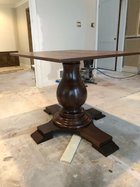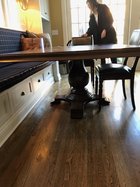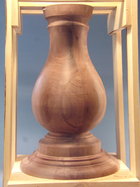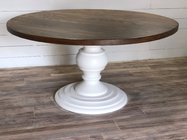58" round table top 6/4 thick - anyone have advice on turning a round pedestal base for it?
-
Beware of Counterfeit Woodturning Tools (click here for details) -
Johnathan Silwones is starting a new AAW chapter, Southern Alleghenies Woodturners, in Johnstown, PA. (click here for details) -
Congratulations to Keven Jesequel for "Big Leaf Maple" being selected as Turning of the Week for April 15, 2024 (click here for details) -
Welcome new registering member. Your username must be your real First and Last name (for example: John Doe). "Screen names" and "handles" are not allowed and your registration will be deleted if you don't use your real name. Also, do not use all caps nor all lower case.
You are using an out of date browser. It may not display this or other websites correctly.
You should upgrade or use an alternative browser.
You should upgrade or use an alternative browser.
Turn a Pedestal Table Base?
- Thread starter Neil Super
- Start date
I think Ashley Harwood and Keith Gottschall have videos on youtube of turning large table bases. They're both accomplished turners and teachers.
Roger Wiegand
Beta Tester
All of the old ones I've ever seen are done with barrel stave construction of the blank, so they are hollow in the middle and don't expose end grain anywhere around the circumference. This also lets you make it from wood of a reasonable thickness.
You may want to consider cutting mortises for the legs prior to making the pedestal round, otherwise you'll have to rig up some kind of jig to hold everything in place to make the cuts.
You may want to consider cutting mortises for the legs prior to making the pedestal round, otherwise you'll have to rig up some kind of jig to hold everything in place to make the cuts.
The Ashely Harwood YouTube video is a good one for covering the process from start to finish.
You definitely want a heavy solid base and pedestal support for the large wood table top.
You definitely want a heavy solid base and pedestal support for the large wood table top.
- Joined
- Jan 27, 2005
- Messages
- 12,895
- Likes
- 5,178
- Location
- Dalworthington Gardens, TX
- Website
- pbase.com
I moved this thread from the Marketplace to the Woodturning Discussion forum.
I have a 48" diameter (not including the 18" leaf that we never use) dining table with a pedestal base. The height of the pedestal needs to be sized so that the tabletop will be 30" above the floor. Don't forget to include the stretchers in this calculation ... so, subtracting 1½" for the table slab, ¼" floor clearance, and 2" for the stretchers leaves 26¼" for the total pedestal height. The pedestal on my table uses staved construction with 16 staves. Each stave is 2⅛" wide and approximately 1¾" thick ... one edge is square and the other has a bevel angle of 22½° so that when assembled you will have an octagon that is approximately 10¼" measured across opposite flat sides. The lower part where the legs attach remains octagonal with a height of 12" including the pommel cuts at both ends. This part needs to be done precisely so that the pommel cuts match all the way around. The four legs installed on the pedestal of my table fit in a 44" circle so the horizontal length of each leg is 17". Use two hanger bolts on each leg to fasten them to the pedestal. The legs on my table have claw feet, but there are many styles. Leg levelers would be essential in my opinion because most floors aren't perfectly flat and a butter knife under one of the feet isn't the best long-term solution ... for either the table or the butter.
I have a 48" diameter (not including the 18" leaf that we never use) dining table with a pedestal base. The height of the pedestal needs to be sized so that the tabletop will be 30" above the floor. Don't forget to include the stretchers in this calculation ... so, subtracting 1½" for the table slab, ¼" floor clearance, and 2" for the stretchers leaves 26¼" for the total pedestal height. The pedestal on my table uses staved construction with 16 staves. Each stave is 2⅛" wide and approximately 1¾" thick ... one edge is square and the other has a bevel angle of 22½° so that when assembled you will have an octagon that is approximately 10¼" measured across opposite flat sides. The lower part where the legs attach remains octagonal with a height of 12" including the pommel cuts at both ends. This part needs to be done precisely so that the pommel cuts match all the way around. The four legs installed on the pedestal of my table fit in a 44" circle so the horizontal length of each leg is 17". Use two hanger bolts on each leg to fasten them to the pedestal. The legs on my table have claw feet, but there are many styles. Leg levelers would be essential in my opinion because most floors aren't perfectly flat and a butter knife under one of the feet isn't the best long-term solution ... for either the table or the butter.
In Robust's video demonstrating the capabilities of the Sweet 16 Lathe, Brent English turns a pedestal base (as well as the table top and the pedestal column). While the video is focused on the lathe and the turning, you can get a sense of how the base was assembled.
In 1985 I built my dinning room table and followed the directions in Fine Woodworking magazine for a Lions foot pedestal table. The column was stave construction, which like Roger W stated allow the use of more reasonable lumber and is more stable.
The table base in the attached picture was a commission I did about 5 years ago in laminated walnut. The wide variation in diameters, the lack of equipment to cut staves that wide, the lack of material to make that size stave and time limitation prevented me from going the stave route. The turned base when first delivered cracked overnight so I had to take it back repair the crack and hollow out the bottom something like doing a hollow form to relieve the stress.


The table base in the attached picture was a commission I did about 5 years ago in laminated walnut. The wide variation in diameters, the lack of equipment to cut staves that wide, the lack of material to make that size stave and time limitation prevented me from going the stave route. The turned base when first delivered cracked overnight so I had to take it back repair the crack and hollow out the bottom something like doing a hollow form to relieve the stress.


I haven't done one yet. First step, for me, would be to draw it out full scale. That really is a HUGE help to figure out design details. Hope you have a work bench/table big enough for that... Well, hope you can push enough stuff off to the side anyway..
robo hippy
robo hippy
Thanks for the responses; I've never posted on this forum despite being with AAW for years. Watched the inspiring Ashley Harwood video (man, where's she been my whole life?). I've included a sample pic the customer provided; he has the round table top (58"x 1.5'thick, cherry) and wants a base similar to that pictured, which he will be painting, so I'm thinking poplar, maybe soft maple. The foot itself will be 38" or so (2/3 of table width), but the rest of what I suppose one would call the pedestal has got me thinking: does it have to be stave construction, or could I glue up several wide enough boards and make a straight spindle? (I realize that the base of course would be in 2 pieces if done that way)
Attachments
You could do solid wood for the pedestal column, but I would worry about it cracking. That is a pretty big chunk of wood, and wood always moves. The foot of this one would pretty much have to be made from flat board stock. I would still want to hollow out some of the bottom, just for weight, though not sure because you may want extra weight in the bottom for stability.
robo hippy
robo hippy
Neil,
When it comes to larger turning projects you usually are left with the option of the wood blanks you can readily source. The large diameter base would be easier to laminate some flat stock to get the dimension you need for the thickness and overall diameter. The pedestal you have several options, locate a spindle of the length and diameter to do the job, or laminate several pieces together and then turn it to the desired shape. If they are going to paint the pedestal then the grain orientation is not a big issues. Cutting flat stock in round pieces and gluing them together in a tall spindle and then turning it would provide a stable and strong support. You could also cut and glue staves together and then turn it to the desired pedestal shape. A metal tube or pipe could be inside the center of the pedestal if the strength is a concern.
When it comes to larger turning projects you usually are left with the option of the wood blanks you can readily source. The large diameter base would be easier to laminate some flat stock to get the dimension you need for the thickness and overall diameter. The pedestal you have several options, locate a spindle of the length and diameter to do the job, or laminate several pieces together and then turn it to the desired shape. If they are going to paint the pedestal then the grain orientation is not a big issues. Cutting flat stock in round pieces and gluing them together in a tall spindle and then turning it would provide a stable and strong support. You could also cut and glue staves together and then turn it to the desired pedestal shape. A metal tube or pipe could be inside the center of the pedestal if the strength is a concern.
I would recommend that you use a non turned base similar to the one shown on my first reply since that would provide a wider stronger base then a big round one similar to the example photo. The base of the turning on the walnut column is an 8 segment piece and the main column is laminated as you can see from the photo of the column as crated.



